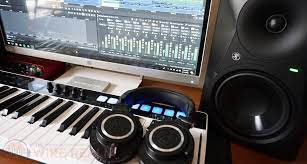Step 1 – Hardware
Let’s start by looking at the hardware required to begin beat-making.
Item 1 – Audio interface
An audio interface is an equipment piece that acts as an external sound processing unit. This is also the main unit responsible for processing virtual instruments and effects.
The ASIO programming language is used to program these puppies. Its processes sound extremely efficient. These puppies come with pre-amps that boost the signal from any physical instrument you plug into them (such as guitar, bass, or vocals). They can also handle a huge load of virtual instruments when creating tracks.
It is essential to have sufficient processing power to create these beats on a desktop or laptop computer. This task is not possible on your computer alone with the sound card.
When purchasing electronic equipment, it’s always a good idea to plan for the future. You should invest in hardware that can handle multi-layered beats and vocals later.
Item 2 – Midi Controller
The midi controller may be where I can get in touch on some familiar ground. It’s a digital keyboard! It’s not like your Casio keyboard. This device controls virtual instruments which are stored on your workstation.
A midi controller opens up the possibility of creating improvised melodies. Nothing is better than listening to a percussion beat and experimenting with it in real-time to find the best sound.
Each audio workstation includes a “piano roll” – basically, an on-screen piano. It cannot be easy to use, especially if you aren’t familiar with the layout of the piano. The piano roll is the most accurate method of laying down the percussion track, but you can also use your midi controller for melodies and other sounds to complement the beat.
These controllers plug directly into your computer via USB. It usually takes little or no effort to set it up for recording.
Item 3: Monitors and headphones
You will need a good set of headphones or speakers to create and release your music. These do two things. This is a great way to hear what you are recording clearly and allows for the best sound quality.
What does this mean? In reality, the best speakers are not necessary for mixing. You can create a false impression of a well-rounded mix when you don’t have one. Monitors can be a balanced and honest representation of your audio.
It isn’t very pleasant to hear a new track on your friend’s car speakers and have it sound completely different from what you’re used to. A set of good monitors or headphones will ensure that your music sounds the same regardless of what speakers it is being played on.
Step 2 – The DAW
DAW is a fancy acronym that stands for a digital audio workstation. Have you heard of Fruity Loops and Pro Tools? These are digital audio workstations.
The most important decision in your beat-making journey is to purchase a DAW. This software will host all virtual instruments that you will use in your tracks. It is important to do extensive research to determine which one suits your workflow and tastes the best.
Assume that you are creating a kitchen. You will have your favorite pots and knives in this kitchen. While you may have the same pots and knives as another kitchen, this kitchen is yours. It’s your kitchen. Your DAW is the kitchen, and your virtual instruments and effects are the pots and knives. The same virtual instruments may be found in two different DAWs. It can feel awkward to use a kitchen in another person’s home.
All DAWs of the highest quality are identical in most respects. The way they are presented within the software makes them intuitive or confusing. Make wise choices.
Step 3 – The VSTs
VST, as mentioned previously, is a fancy acronym that stands for virtual studio technology. Also known as virtual instruments and effects.
Selecting the right VST is not a zero-sum proposition. There are many virtual instruments available. These instruments can be used for everything from Hip Hop percussion instruments to whole orchestra sections. There are so many options. Choosing the right ones for your needs is important while keeping your wallet intact. They can quickly become very expensive.
To slightly modify my comments about DAWs, you can choose a more expensive DAW to save on VSTs. How? Unfortunately, Reaper does not include virtual instruments. Only effects. You can get another premium DAW, Logic Pro, and use their VSTs (which are incredible). You don’t need to purchase a lot of VSTs to create some tracks. Logic Pro can only be downloaded on Macintosh.
This guide will help you get started if you are completely new to beat-making.
It will not be easy to get started in music creation. It will be worthwhile to see your beats come alive in the end.
YouTube and forums can be your best friend when you have technical difficulties. As always.
